Like roots, the stems also undergo modifications to perform various special functions. When a permanent change occurs in the structure of stems to perform new functions suitable for the environment, it is called as a ‘stem modification’. Based on their nature, stem modifications are of three types namely,
1. Tendrils: Some weak stemmed plants produce wiry, coiled sensitive and delicate organs called tendrils. Tendrils are useful for climbing. When the tendrils come in contact with the support they coil around the support and help the plant in climbing. The tendrils may develop either from axillary buds or terminal buds.
In Passiflora, the axillary bud develops into a tendril while in Cissus quadrangularis and Vitis vinifera the, terminal buds develop into tendrils.
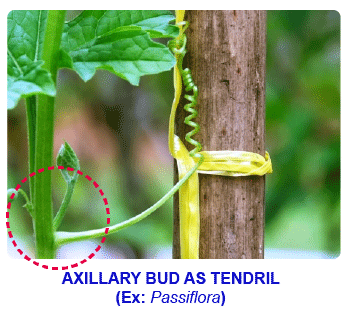
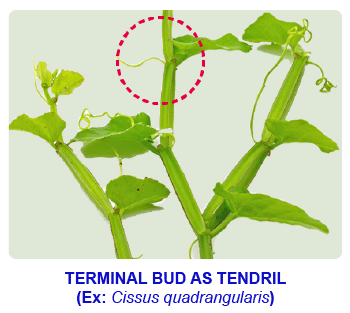
2. Thorns: Thorns are hard woody, pointed structures meant for protection. They are provided with vascular tissues. They may either develop from axillary buds or terminal buds.
In Bougainvillea, Punica granatum and Duranta axillary buds develop into thorns and help in climbing while in Carissa carundus terminal bud produces a pair of thorns to help in protection. In Duranta, thorns bear leaves and flowers. In Punica granatum, the thorns bear leaves and branches.
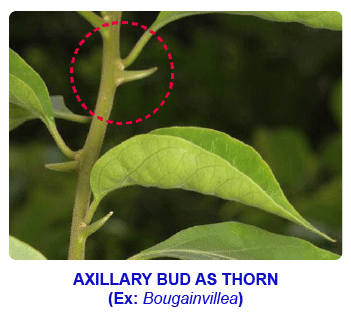
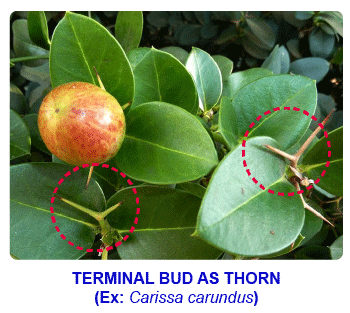
3. Hooks: These are woody, curved and sensitive structures developed either from axillary buds or terminal buds. In Hugonia axillary buds of opposite leaves develop into hooks. In Artabotrys the apical bud is modified into an inflorescence and the peduncle is modified into a hook which helps in climbing.
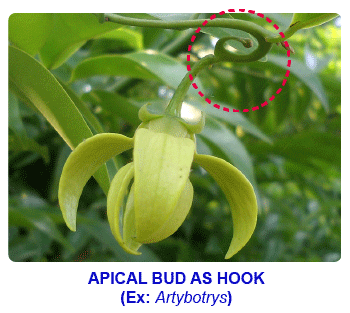
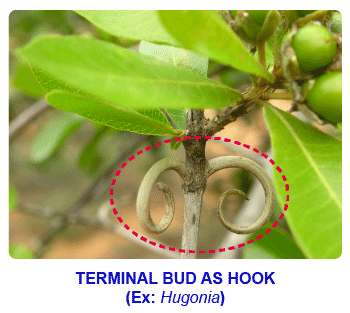
4. Phylloclade: It is a special modification of stem. Generally the plants growing in drought areas and deserts show many adaptations to control the rate of transpiration. In these plants the leaves are modified into scale leaves or spines. In such plants the main stem or branches are modified into green, leaf like structures to perform the function of photosynthesis. These leaf-like stems are called ‘phylloclades’.
Example: Opuntia, Cocoloba, Casuarina etc.
In Opuntia all the leaves of axillary bud modify into a group of spines. Some spines are small and appear as hairs. They are called barbs. The group of barbs spines present at every node is known as areole.
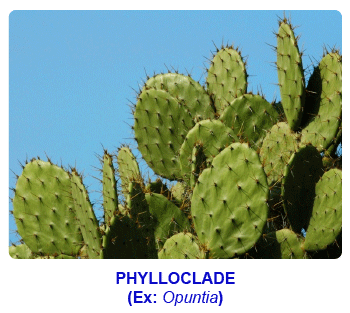
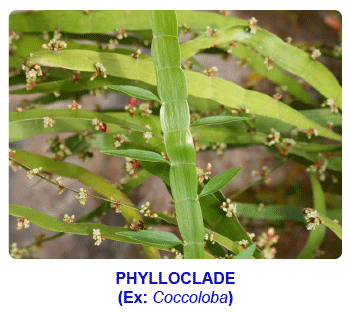
Cladophyll or cladode: In some plants one or more short green cylindrical or sometimes flattened branches of limited growth develop from the node of the stem or branch in the axil of a scale leaf. Such a branch is known as the cladophyll. It is a variation of phylloclade.
Example: Asparagus, Ruscus
In Asparagus, the cladophylls are green and cylindrical and are produced in the axils of scale leaves. Here the cladodes are one internode length.
In Ruscus the green flat, leaf like organs are the cladophylls. They bear male or female flowers from a point half-way up on their surface in the axil of another scale leaf. Here the cladodes are two internodes length.
5. Tuberous Stems: The aerial stems which store food materials and become tuberous are called tuberous stems.
Example: Brassica oleracea gangyloides (knol kohl), Bulbophyllum
In Bulbophyllum, an epiphyte, generally one internode (or sometimes of the stem stores food and water and becomes tuberous. It appears as a bulb like structure and is called pseudobulb. Due to this adaptation, the plant can survive during unfavorable conditions.
In Knol-khol entire stem is modified into green tuberous stem.
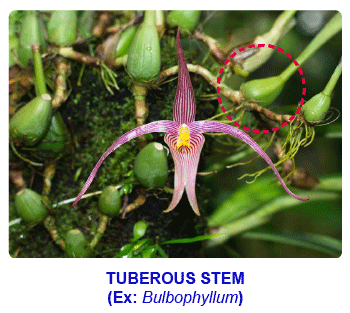
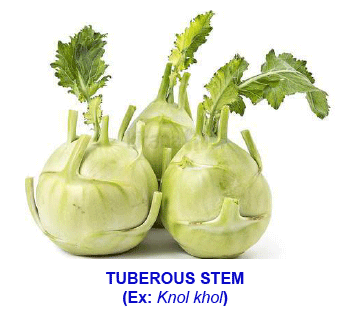
6. Bulbils: In some plant species the vegetative and floral buds are modified into condensed branches. They store food materials. These modified buds are called ‘bulbils’. At maturity the bulbils develop into new plants by producing adventitious roots as they get separated from the plant. In this way they participate in vegetative propagation.
In Dioscorea bulbifera bulbils develop from the axils of leaves. In Agave Americana and Globba bulbifera they develop in the axils of bracts on the inflorescence. In some species of Oxalis a group of bulbils arise from the ground level at the apex of tuberous root.
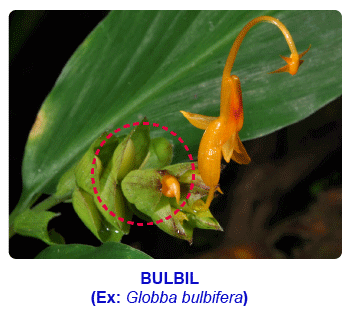
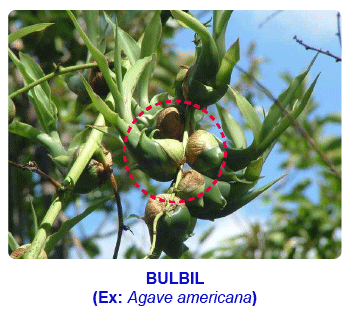
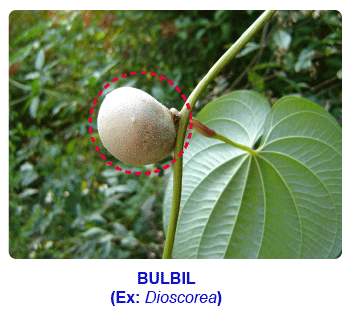
In some weak stemmed plants the stem remains partly aerial and partly underground. These stems are called sub-aerial stems. These are specialized for vegetative propagation. There are four types of sub-aerial stems namely Runners, Stolons, Suckers and Offsets. Let us study each of them,
1. Runners: In some weak stemmed plants the stems creep on the soil and are rooted at node. When the internodes break off, the nodes lead an independent life. These weak stemmed plants are called runners. They help in vegetative propagation.
Example: Hydricotyle vulgaris, lippia nodiflora and some species of Oxalis.
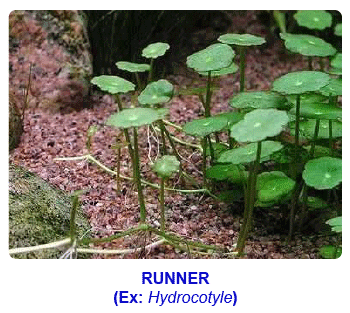
2. Stolons: In some plants the long slender branches arise from the base of the stem obliquely downwards. When these branches touch the soil they produce adventitious roots. These branches are called ‘stolons’. When these stolons are separated from the plant they live as independent plants. Method of raising plants vegetatively through layering depends mainly on stolon principle.
Example: Nerium, Jasminum and Rosa. Suckers
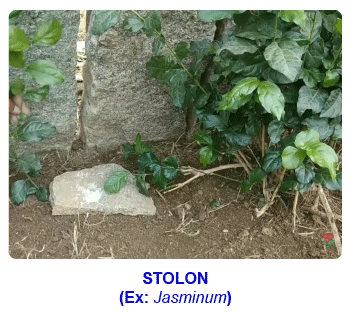
3. Suckers: In plants like Chrysanthemum and Mentha part of the stem is in the soil. Underground branches grow obliquely upward from the axillary buds of nodes present below the soil. These branches produce many adventitious roots from their lower surface. These underground branches are called ‘suckers’. When these suckers are separated they develop into new plants.
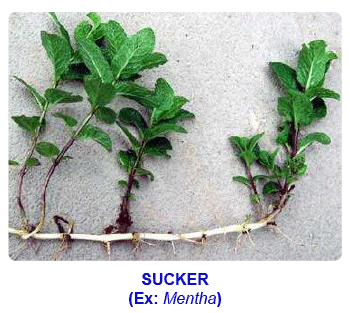
4. Offsets: They are found in free floating water plants like Pistia and Eichhomia. In these plants the stem is reduced to a disc like structure. Many leaves are developed from this stem in rosette manner. The axillary bud of these leaves develop into short, slender branches of usually one internodal length and grow horizontally above the water. These branches are called ‘offsets’. The apex of each offset bears a cluster of leaves on the upper side and adventitious roots on the lower side. When these offsets break-off they develop into new plants. Offsets are rarely found in terrestrial plants like Agave Americana.
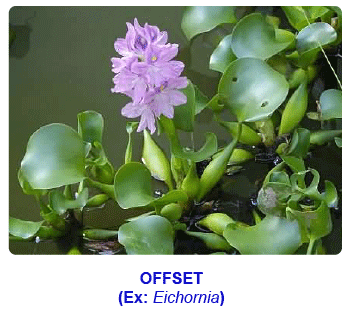
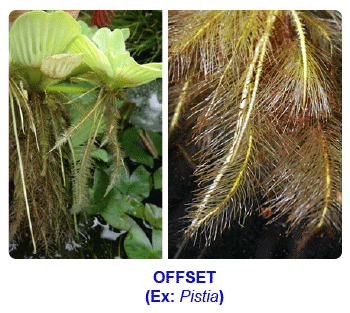
Formally the stems are aerial. But in some plants they grow below the soil. Such type of stems is called ‘underground stems’. They store food materials and become fleshy and bulky. They also act as organs of vegetative propagation and perennation. Since these stems grow underground they are protected from herbivorous animals. As they perform all these functions the underground stem modifications are also called multipurpose stem modifications. These stems contain nodes, internodes, scales, leaves, axillary and terminal buds. Based the growth pattern and the parts in which food material is stored, these stems are further divided four types namely Rhizome, Corm, Stem tuber and Bulb. Let us study each of them,
1. Rhizome: It is an underground stem which grows horizontally below the soil. It contains nodes and internodes. It is dorsi-ventrally differentiated and produces aerial branches as “well as reproductive organs from the dorsal side and adventitious roots from the ventral side. Scale leaves are present at the nodes. The branches developed from the axillary buds not only store food materials but maintain horizontal growth of the rhizome Terminal bud develops and produces aerial branches. The underground rhizome remains alive even in drought conditions.
Example: Zingiber officinalis, Curcuma longa, Musa paradisiaca and Carina indica
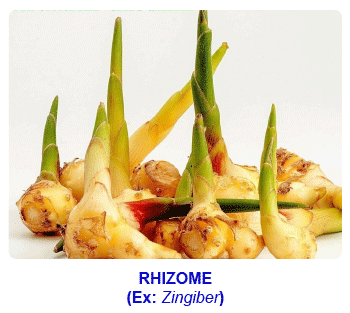
2. Corm: This underground stem grows vertically in the soil at a particular depth. It stores food materials that are synthesized in the aerial branches and become tuberous. It bears nodes and internodes. Leaves are reduced to scale leaves. The axillary buds of these scale leaves produce daughter corms. Apical bud is big and produces aerial shoot Adventitious roots normally develop from the base but sometimes also from the sides,
Example: Amorphophallus and Colocasia
Some plants like Amorphophallus corm is kept at a particular depth in the soil by some special adventitious roots called ‘contractile roots’ or ‘pull roots’.
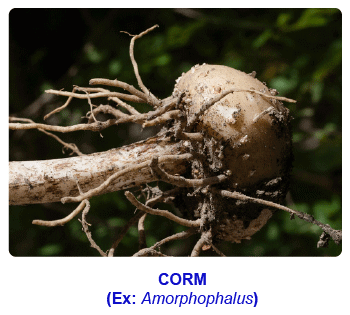
3. Stem tuber: In some plants the branches which develop from the lower part of the stem into the soil. The apices of these underground branches store food materials and become tuberous. These are called ‘stem tubers’,
Example: Solanum tuberosum (potato), Helianthus tuberosus, Stachys tubifera.
The tuber is covered by brown colored layer. It bears many ‘eye’ like structures which represent the nodes. Each ‘eye’ possesses a semilunar leaf scar and an axillary bud in its axil. Scar represents the position of scale leaf. These stem tuber-eyes help in vegetative propagation of the plant. Stem tubers do not have roots. In potato the stem tuber stores starch. The stem tuber of Helianthus tuberosus stores ‘inulin’ and that of Stachys tubifera stores ‘stachyose’.
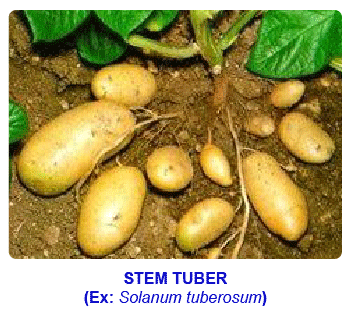
4. Bulb: It is a special type of underground stem. In this the stem is reduced to a biconvex shaped disc like structure. It does not store food materials. The disc bears many adventitious roots on its lower side. Many leaves develop on the upper side of the disc and grow above the soil. The leaf bases (scale leaves) store food and water and become fleshy. The axillary buds produce daughter bulbs. The terminal bud present at the center of the bulb develops into an aerial shoot producing inflorescence. Daughter bulbs help in vegetative propagation. Bulb is considered as the only underground stem which does not store food.
Depending upon the arrangement of scale leaves the bulbs are of two types.
Tunicated bulb: In this type the fleshy leaf bases or scale leaves overlap one above other in concentric circles. The entire bulb is covered by dry membranous scale leaves called ‘tunic’.
Example: Allium cepa (onion). 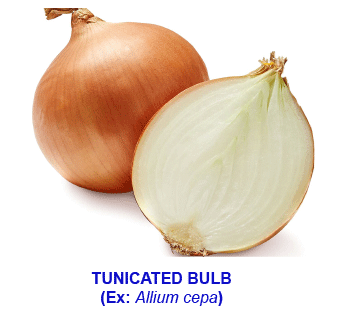
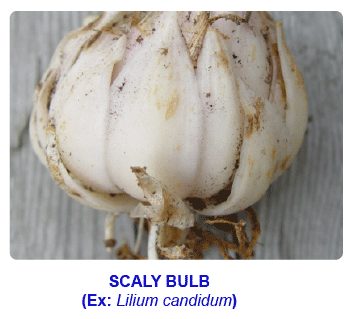
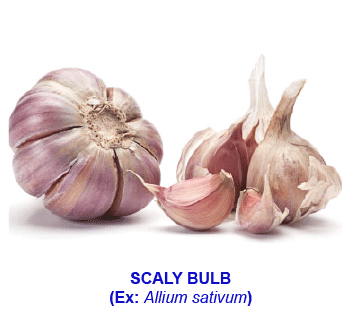
Scaly bulb: It is also called ‘imbricate bulb or naked bulb’. In this the scale leaves fleshy and are loosely arranged. The whole bulb is not covered by tunic.
Example: Lilium candidum, Allium sativum (Garlic). In Allium sativum a number of fleshy scale leaves called cloves are arranged as scaly bulbs and group of such cloves are enclosed in a whitish skinny tunic.
Difference between Rhizome and Corm
| Rhizome | Corm |
|---|---|
| It is an underground stem which grows horizontally | It is an underground stem that grows vertically |
| It is dorsiventral with adventitious roots on the ventral side | It is not dorsiventral Adventitious roots normally develop from the base |
| Apical bud is small | Apical bud is large |
| Contractile roots (or pull roots) are absent | Contractile roots (or pull roots) are present |
| Example: Ginger, Turmeric | Example: Amorphophallus |
Difference between Tuberous stem and Stem tuber
| Tuberous stem |
Stem tuber |
|---|---|
| Tuberous stem is an aerial stem that stores food material | It is a swollen tip of an underground branch |
| It has roots | It does not have roots |
| It is usually green in colour | It is brown in colour |
| Byes are absent | Eyes are present |
| Example: Knol-kohl | Example: Potato |
Difference between Bulb and Bulbil
| Bulb | Bulbil |
|---|---|
| It is a small reduced underground stem | Itis amodified vegetative or floral bud |
| It does not store food materials. The food is stored in leaf bases or scale leaves | It stores food material |
| Daughter bulbs that develop from the axillary buds grow into new plants | Bulbils detached from the parent plant develop into individual plants |
| It bears adventitious roots on the lower surface | It does not bear adventitious roots till germination |
| Example: Aillum, Lilium | Example: Dioscorea, Agave, Globba |
Hope you have liked this post.
Please share it with your friends through below links.
All the very best from Team Studyandscore
“Study well, Score more…”
- Share with your friends! -
Login to post your comment here...
- or with social Account -